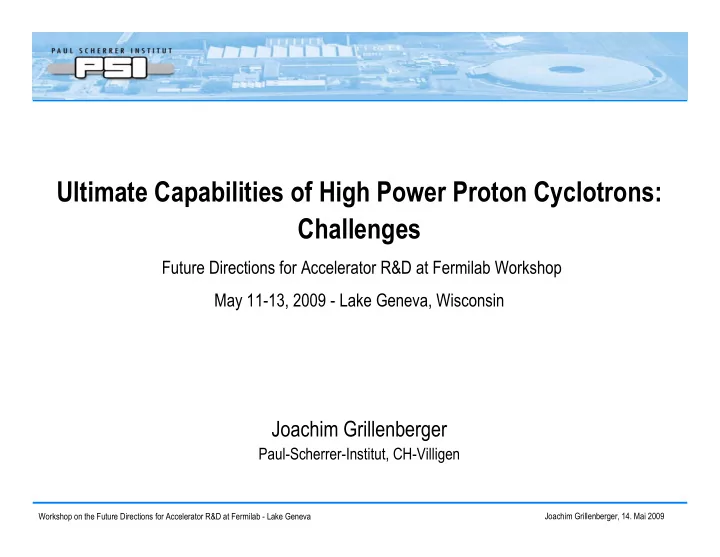

Ultimate Capabilities of High Power Proton Cyclotrons: Challenges Future Directions for Accelerator R&D at Fermilab Workshop May 11-13, 2009 - Lake Geneva, Wisconsin Joachim Grillenberger Paul-Scherrer-Institut, CH-Villigen Workshop on the Future Directions for Accelerator R&D at Fermilab - Lake Geneva Joachim Grillenberger, 14. Mai 2009
Paul-Scherrer-Institute, Villigen Switzerland Hot laboratory Hot labora tory Solar concentrator Solar concentrator Nano structuring Nano structuring Proton therapy Proton therapy Proton facility Proton facility PROSC PROSCAN Spallation neutron Spallation neutron Source SINQ Source SINQ Swiss Light Source Swiss Light Sourc SLS SLS Aare Aare Workshop on the Future Directions for Accelerator R&D at Fermilab - Lake Geneva Joachim Grillenberger, 14. Mai 2009
Outline • Operational experience with the 590 MeV Ring-Cyclotron [upgrades, goals, performance statistics ] • Proposal for a 10 MW Driver [scheme, data, options ] • Challenges [cavities, electrostatic elements] • Conclusion Workshop on the Future Directions for Accelerator R&D at Fermilab - Lake Geneva Joachim Grillenberger, 14. Mai 2009
Layout of the PSI proton facility Cockcroft-Walton (870 keV) 2.2 mA of protons at 590 MeV Injector 2 72 MeV Ring Cyclotron
590 MeV Ring Cyclotron in April 2008 - 8 sector Magnets: 0.6 – 0.9 T - weight per magnet: 250 tons - 4 cavities 50.63 MHz: 850 kV - 1 flat-top resonator: 150 MHz - harmonic number: 6 - beam energy: 590 MeV - beam current (now): 2.2 mA - injection radius: 2.1 - extraction radius: 4.5 m ~2 10 -4 - relative losses:
Upgrades and Goals New ECR ion source Injector II resonators 3rd harmonic buncher (2.7 mA from Inj 2) 10th harmonic buncher Goal: extract 3.0 mA of protons at 590 MeV ≙ 1.8 MW keep losses constant! Cu-Resonators (each max. 1 MV instead of 750 keV)
High power resonators Cu Resonators f = 50.63 MHz - less wall losses - better breakdown characteristics - higher gap voltage possible (1 MV) - better cooling distribution - regulation precision ~10 m transfer of 500 kW power to the beam per cavity
Losses in Ring cyclotron as a function of current Achieved 2008: gap voltage increase : 780kV 850kV turn number reduction : 202 186 losses reduced by turn number reduction Goal: 150 turns
History of the beam-current and turn numbers in the PSI Ring Cyclotron by W. Joho → fast acceleration and short bunches
New record current: 2.2 mA @ 590 MeV ≙ 1.3 MW First attempt to reach 2.2 mA. Was achieved within 5 h! • legal authorization for continuous currents up to 2.2 mA was given by Swiss authorities • authorization for up to 2.4 mA ≙ 1.4 MW for testing purposes every other week for two shifts (16 hours) → en route
Performance statistics For the application of cyclotrons in ADS systems the frequency of trips is of major interest uninterrupted run period new record: 21 hours! Typical duration of short trips ~30sec
Statistics on technical failures • operation is typically distorted by short (30 s) interruptions • significant improvement with reduced number of turns • number of short interruptions reduced from 61/day (2007) to 28/day (2008) • 0.5 failures per day that take longer than 10 min for recovery • rate of longer interruptions (i.e. component failures) is not improved • overall availability of the proton facility is now 95%
Proposal for a 10 MW driver Electrostatic extraction Sector magnets channel RF-cavities Flat-top resonators Th. Stammbach et al. NIM B 113 (1996) l-7
Superconducting sector magnets allow the installation of more RF-cavities and Electrostatic extraction channel thus a higher energy gain per turn. Parameter 1 GeV Ring PSI Ring Energy 1000 MeV 590 MeV Current 10 mA 2.2 mA (3.0 @ 4 MV/turn) Magnets 12 (B max = 2.1 T) 8 (B max = 1.1 T) Cavities 8 (1000 kV) 4 (850 kV) Frequency 44.2 MHz 50.63 MHz Flat tops 2 (650 kV) 1 (460 kV) Injection energy 120 MeV 72 MeV Injection radius 2.8 m 2.1 m Extraction radius 5700 mm 4462 mm Number of turns N 140 186 Energy gain at 6.3 MeV 2.4 MeV extraction R/ N 11 mm 5.7 mm 7 7 Turn separation Beam power 10 MW 1.3 MW (2.4 MW)
Component activation – Ring Cyclotron (interpolated) individual dose for 3 month shutdown: 57 mSv, 188 persons max: 2.6 mSv cool down times for service: 2000 1700 A for 2h 0 A for 2h electrostatic extraction channel
Minimize extraction losses Increase turn separation at extraction: Critical: parameters of electrostatic elements Number of turns: 140 bending radius: 7 mrad Energy gain: 7 MeV / turn Electric field: 9 MV/m → 1.2 MW power transfer to the beam per → 150 kV between electrodes cavity is required for the proposed system anode must be “invisible” for the beam Scheme of extraction channel
Modeling of High Intensity Beams in Cyclotrons Courtesy: A. Adelmann
Avoid tail generation → 10th harmonic buncher in injection line Cockcroft-Walton 1 MeV Injector cyclotron 120 MeV
Therefore, we think that... Important issues Why? • sufficient beam-current and energy • extraction losses • CW-operation • decrease number of trips (el. stat. elements) • low losses (sectors, cavities, bunchers) • intercept component failure (redundancy) • cost effective, efficiency >40% • RF-design with reserve • reasonable size • reliable ion source (solved: ECR) • modular design • machine protection ( diagnostics, collimators, targets ) • easy maintenance (individual dose) • space charge limits (flat-tops or bunchers) • sound theoretical background • Injector required Workshop on the Future Directions for Accelerator R&D at Fermilab - Lake Geneva Joachim Grillenberger, 14. Mai 2009
High Power Proton Accelerators PSI Parameters: 2.2 mA ≙ 1.3 MW 3mA ≙ 1.8 MW The PSI cyclotron based facility still delivers the highest average beam power
Yes we can! Thank you for your attention! Workshop on the Future Directions for Accelerator R&D at Fermilab - Lake Geneva Joachim Grillenberger, 14. Mai 2009
Recommend
More recommend